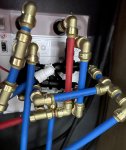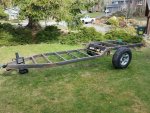Treefarmer
Active member
Another note for those of us starting to use the Cruise Master ATX suspension (Kingdom Camping, Roamer1, X195/145, etc.). I've been going back and forth with the CM support group in Australia about best practices for maintaining and using the ATX system. I was particularly curious about what inflation level to use if you are sitting stationary in camp for a long period of time (or in storage). The factory says that when stationary it's best to always keep the system inflated to highway cruising height or maybe a little bit lower. You don't want to deflate the system low enough that the bump stops are carrying much trailer weight and the air bags are compressed. Excess weight on the bump stops and compressed/deflated air bags will lead to damage in both components over time. If the system is working properly, the air bags shouldn't lose more than about 1 PSI every seven days or so. When you are at camp and you want to lower the air pressure in the bags to make the step up into the trailer easier, be sure to not let too much air out of them.
As soon as the ATX suspension was installed in our trailer, they aired up the system to keep the weight of the trailer off the bump stops and keep the air bags from being compressed for the duration of the build. They also said that they aren't seeing any air seepage in the system yet, but if they do, the wireless remote makes it easy to adjust the pressure at any time.
As soon as the ATX suspension was installed in our trailer, they aired up the system to keep the weight of the trailer off the bump stops and keep the air bags from being compressed for the duration of the build. They also said that they aren't seeing any air seepage in the system yet, but if they do, the wireless remote makes it easy to adjust the pressure at any time.


